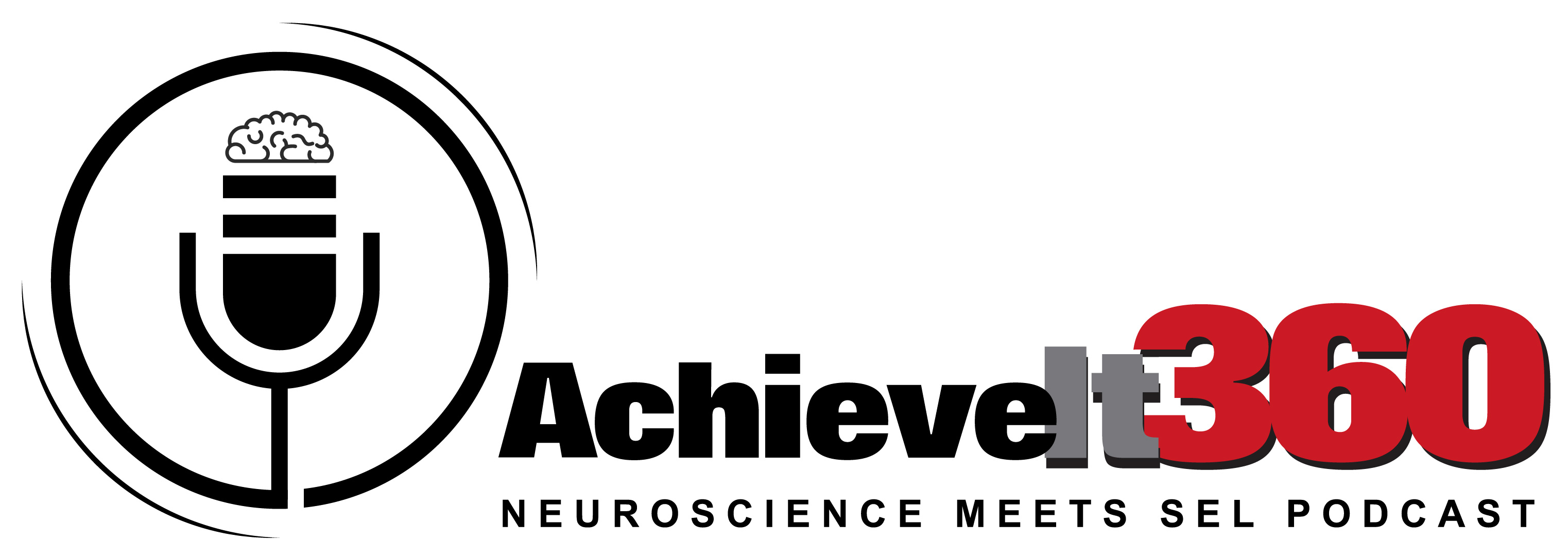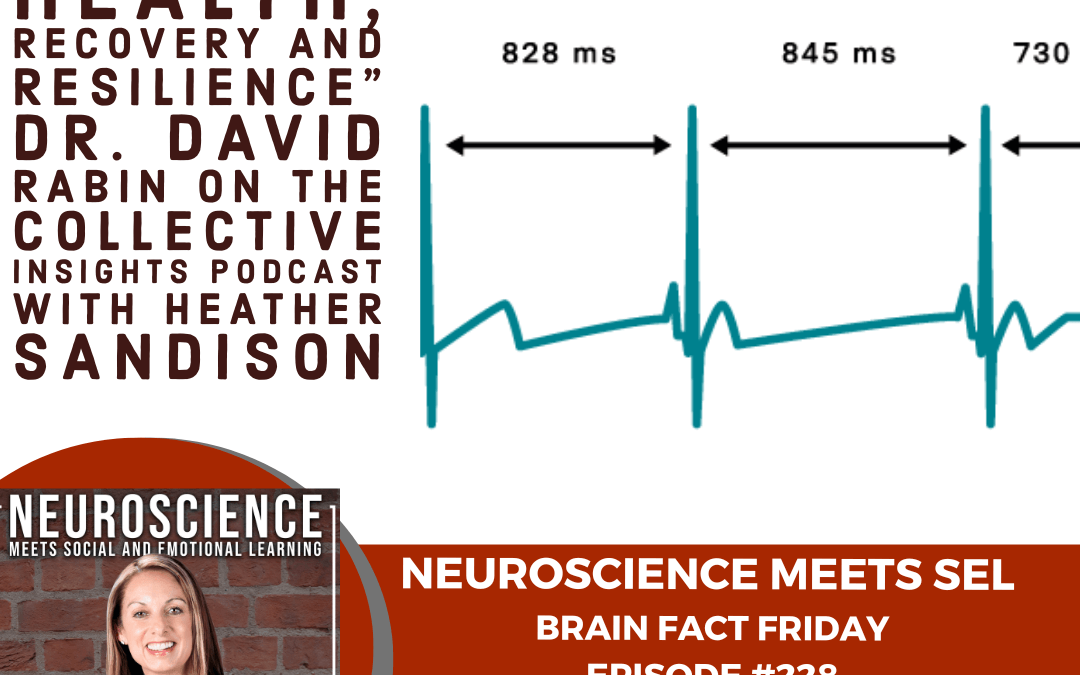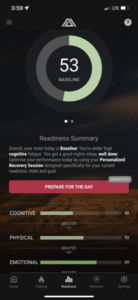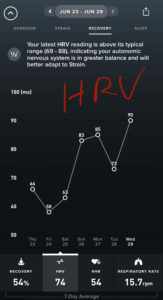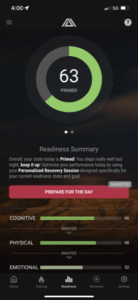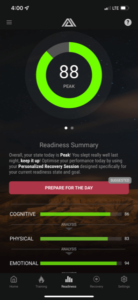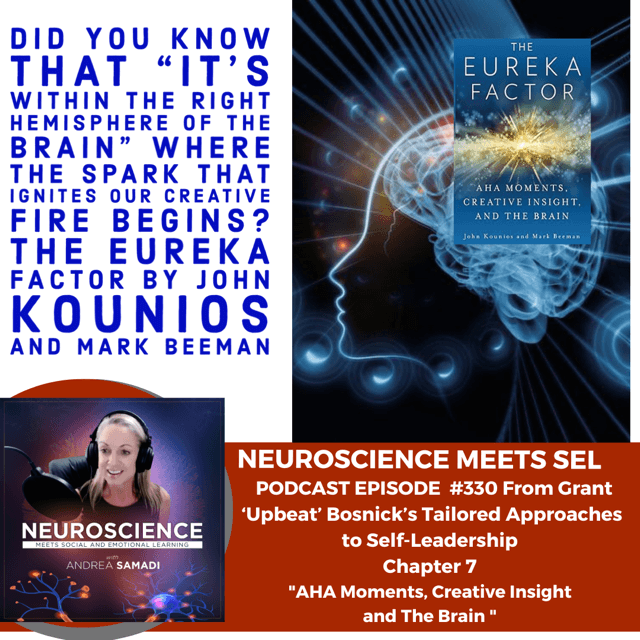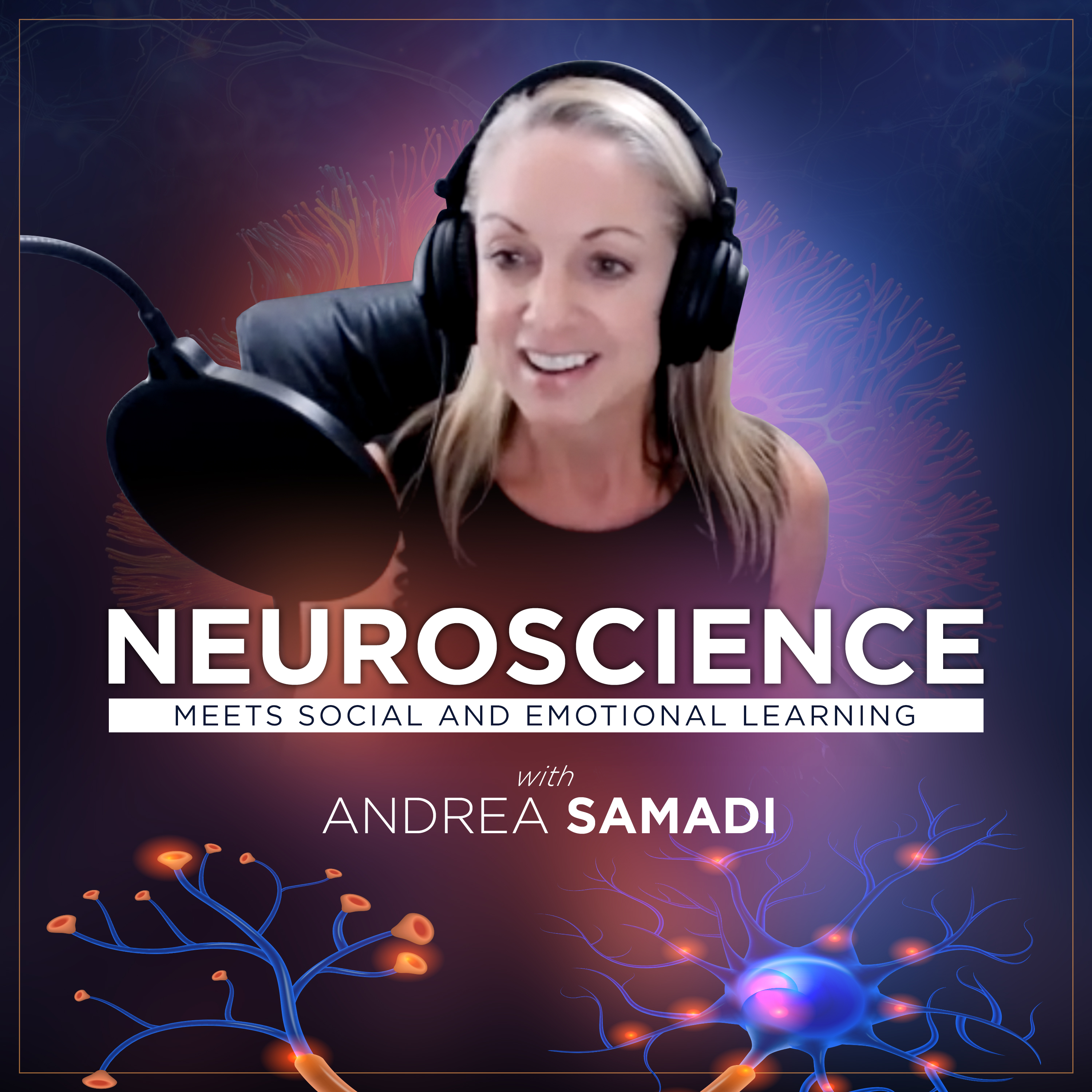Welcome back to The Neuroscience Meets Social and Emotional Learning Podcast, where we cover the science-based evidence behind social and emotional learning (for schools) and emotional intelligence training (in the workplace) with tools, ideas and strategies that we can all use for immediate results.
I’m Andrea Samadi, an author, and educator with a passion for learning specifically on the topics of health, wellbeing and productivity, and launched this podcast to share how important an understanding of our brain is for our everyday life and results–whether we are a teacher or student in the classroom, or in working the modern workplace.
For today’s Brain Fact Friday, I wanted to revisit a topic that we have covered once already on the podcast, Heart Rate Variability or HRV. We covered an introduction to the importance of understanding HRV back in April of 2021 on EPISODE #125[i] on “What is HRV and Why is it Important for Tracking Health, Recovery and Resilience?” I wanted to go back to this episode and the basics of HRV because it’s such an important number to measure and understand “not just for health and recovery on a regular basis, but (for) resilience.” (Neurohacker.com) Recently, I found myself not being able to explain what it is, or knowing exactly how I can manipulate it for improved results, leading me to take a closer look at what it is, or go back to HRV Basics.
What is Heart Rate Variability (HRV) and Why is it Considered “the Most Important Biomarker–a measure that captures what’s going on in a cell at any given moment that can serve as an early warning system for your health?”[ii]
Unless you have been training with a forward-thinking coach, you’re an elite athlete, or someone who has taken a serious interest in measuring their performance, most of us have not heard of, or really understand what exactly heart rate variability means. From the name, we can tell it has something to do with our heart rate. Maybe you’re like me and you measure your own HRV and have even studied it to see what exactly it is, but when it comes to explaining it to someone else, you just say when asked what it is “that it’s just an important number to know.” When I heard that Dr. Rabin, a board-certified psychiatrist and neuroscientist, would consider HRV to be “the most important biomarker for tracking health” I knew it was time to revisit HRV closely so that I could better understand it myself, and explain it to others with more confidence.
I wondered:
- What is HRV again?
- Why is it the most important biomarker for tracking health, recovery and resilience?
- What tools can I use to measure it?
- Besides clean eating, sleep and rest, how else can I improve this important number?
- Can I dive deeper and look at my HRV, and see if I can manipulate a higher score by doing things a certain way when I’m experiencing high stress or having an off day?
- How can I stay motivated when life is difficult to keep pushing forward and have more high HRV days than low?
REMINDER: WHAT IS HRV?
After reviewing EPISODE 125, where we covered “What is HRV and Why is it Important?” I remembered that this number measures a person’s ability to bounce back from stress. Kristen Holmes and Emily Capodilupo from Whoop are HRV experts and they remind us on their most recent review of HRV that “it’s the timing between the beats of your heart and that the variability comes from the sympathetic side (where we take action) and the parasympathetic side (where we rest or digest).”[iii]
BALANCING OUR PARASYMPATHETIC AND SYMPATHETIC NERVOUS SYSTEM:
Our goal is to find balance between the two parts of our autonomic nervous system. When there’s balance, we will see a lot of variability, or a HIGH HRV that tells us that our nervous system is balanced and that “you have a lot of resources that are available and ready to use.” (Kristen Holmes/Emily Capodilupo, Whoop’s HRV 101 Podcast). This is why more and more athletes are using wearable devices like Whoop, or there’s the Oura Ring[iv], so they can wake up and see their score, and gain some insight into this number over time, using it for their training schedules. If you wake up to a high HRV score, then you know it’s going to be a good day, with lots of resources available to you whether you are an athlete training for an event, or if you just want to operate at your highest capacity.
When your HRV score goes down, it’s because “one set of the inputs, usually the sympathetic (action-taking) part of our nervous system is dominating, producing cortisol and the parasympathetic side, isn’t getting heard.” (Kristen Holmes/Emily Capodilupo, Whoop’s HRV 101 Podcast).
WHY IS UNDERSTANDING THIS NUMBER SO IMPORTANT?
Now that HRV has been explained, (what it is) and I feel that I’ve got a solid understanding of what a high HRV score means, ( I have more capacity to perform) versus a low HRV score, (where I’m not as balanced as I could be), I wanted to review why this number is so important for measuring rest, recovery and resilience.
I listened to Whoop’s most recent podcast on HRV Insights where they took all of their HRV related podcasts and gave the highlights of these on this one episode, and I heard internal medicine and journalist Dr. Bob Arnot, (ar-not) say that “HRV is the best overall marker for biological age—it’s how springy your overall autonomic nervous system is”[v] and world-renowned HRV expert Dr. Daniel Plews said that “knowing your HRV gives you more bang for your buck when you train” and then Whoop’s Vice President of Performance Kristen Holmes, (who joined us on EPISODE #134)[vi] agreed, saying that “you show up with more capacity to training, and that it matters what you did the day before for next day capacity and next day HRV.”
So, a higher HRV number is what we want to look for, if we have a day where our performance is important. Not just for athletes, but also an important number to watch for our productivity in the workplace. Will Ahmed, the founder of Whoop warns us “to avoid comparing your HRV to someone else’s as it’s “me verses me” number, and that we should be concerned with our score versus our baseline, and not ever look over the shoulder of someone else’s numbers to compare.
WHAT TOOLS CAN I USE TO MEASURE THIS SCORE?
Before measuring my HRV with Whoop, (that has a yearly fee associated with it[vii]), I started with a free app[viii] on my iPhone and it felt accurate and was a great place to start. Then I moved to measuring this number with Whoop when I was preparing for my interview #134 with Kristen Holmes[ix] and decided to purchase a membership and try it out.
HOW CAN WE IMPROVE THIS SCORE?
So, if this score is so important, how can we improve it? There are many articles you can read that will give you tips on improving your HRV[x] but world class stunt guy, Steve-O told Whoop that he swears by his high HRV Score with “mindfulness and meditation”[xi] which made me think beyond what we already know with clean eating, sleep and exercise.
While researching HRV on a deeper level, I got an email from the Rewire Fitness App that I had been using, since EPISODE #179[xii] with the CEO of Rewire Fitness[xiii] Sun Sachs, on Their First to Market Neuro Performance Mobile App for Athletes and the email said that I had been entered into a contest to win a prize (and the prizes were actually ones I could really use). The email said that the more we used this app, the more entries we would get into this contest. I thought, “I’m in” thinking that maybe I could see if I could increase my HRV levels with increased usage of this app, but adding something else to the plate is easier said than done, even with these incredible prizes.
Even though I had been using this app regularly since our interview last November, I have to say that I wasn’t using it twice a day (like Jack-O said gave him his noticeable HRV boost) and I was sometimes skipping a day. But this contest motivated me to take this all seriously and test out whether using the app, twice a day, consistently, could manipulate a higher HRV score with predictable results I could use in the future when needed. Here are the results:
DAY 1: Friday July 24th, I took the Rewire Fitness app readiness test that I take first thing in the morning, (that takes just a few minutes and it involves hitting a key when you see a shape appear on the screen) flagged me with high cognitive fatigue. It also showed low scores on the physical track, but my emotional track was looking good. I was tired, and the app picked it up, giving me a Readiness Score of 53 at baseline, was congruent to how I was feeling.
With this new understanding of HRV, after reviewing it last week, it would make sense that my HRV score would also be low, and I went over to the Whoop app to see, and it was. You can see on Friday, my HRV score took a dip down to 58 from 96.Remember, if you do measure your HRV, don’t compare it to mine. 58 that’s a low score for me, could be a high score for someone else. The Rewire app had me do a Mindset Recovery Program that included guided breathing, binaural beats, self-talk, subliminal priming and visualization. I did do two meditations suggested for this day, in addition to what I already do in the morning.
DAY 2: The next day, Saturday July 25th, I woke up, took the 2 minute readiness test as usual, and all of my sc
ores (cognitive, physical and emotional) had improved, giving me a rating of PRIMED with a score that went from 53 to 63. A quick glance at my Whoop app showed that my HRV score went up (just slightly) from 58 to 63 which I was hoping to see. I did do two meditations that the app suggested this day, in addition to what I already do in the morning.
DAY 3: Sunday night, July 25th, I went to bed, and wanted my score to be higher the next day, so that I could make a case for Jack-O’s theory that mediation and mindfulness really does improve your HRV score, and show how the Rewire App took me me from
“Tired to Re-Wired” in one weekend, but I wasn’t sure it would work.Not that I doubted the app, but when we are measuring something like HRV, there are so many different variables that can affect this number. Emily Capadilupo mentioned that if you are slightly dehydrated, this number can be decreased. So, I did everything I knew of, to raise my HRV Sunday night, and Monday morning, woke up to an increased HRV score of 85, and a PEAK score on the Rewire Fitness app that went from 53 on Saturday to 88 on Monday.
RESULTS OF THE EXPERIMENT:
From this weekend experiment, it was clear that meditation and the mindfulness exercises did increase my HRV number, giving me more resources to draw from on Monday morning.
If you are measuring your HRV score over a long period of time, you can play around with this number to see what brings it up, and what takes it down. Obviously when we eat clean, get enough rest, and sleep, our score goes higher. Test it out and see what makes your score go higher for you, or lower. The CEO of Kernal, Bryan Johnson, says his HRV goes up higher when he sings. While my singing isn’t good enough to increase my HRV score, for such an important biomarker for tracking health, recovery and resilience, I plan to continue to do whatever I can to keep this number high.
MOTIVATION:
Which brings me to motivation because there are times that we just don’t feel like doing the activity that we know is important for our health and every day well-being. I often have days like this, and having a system that you can draw energy from within yourself can really help.
EXTRINSIC VS INTRINSIC MOTIVATION:
To review motivation, I revisited Clayton Christensen’s ground-breaking and besting selling book for motivation in the classroom, Disrupting Class, where he reminds us that “motivation can be extrinsic or intrinsic. Extrinsic motivation comes from outside the task where a person might learn to do something not because they found the task itself stimulating or interesting, but because learning it would give them access to something else they want.” This would be like me using the Rewire Fitness app that I had gone off course with, in order to win the prize I wanted, or the sales person who makes extra sales calls to earn a higher commission, or the athlete who trains hard to win that trophy at the end of season. The motivation comes from outside the task.
Intrinsic motivation is when “the work itself stimulates and compels an individual to stay with the task because the task by itself is inherently fun and enjoyable”[xiv] and I noticed this happening after using the app for some time, and seeing my results go up. I really started to enjoy doing the meditations and brain training when I could see how it was helping me to improve. The motivation came from doing the task itself, just like when we exercise, and start to see how great we feel, it’s really hard to stop, once it’s a part of our routine.
I thought about what was motivating me to begin using the Rewire Fitness app 2/day to increase my HRV like Jack-O said worked for him, and it was interesting because although I knew it was an important part of my day to Rewire my brain, sometimes I would forget to do the readiness assessment in the morning (even though it just takes a couple of minutes) but the minute there was a contest to use the app, with prizes I could really use, I suddenly became highly motivated to use the app. I was extrinsically motivated by the contest, and like Clayton Christensen reminded us, this makes learning something new much easier. I was motivated to win the prize, but when I saw how much the app helped improve my HRV, I suddenly became intrinsically motivated, and using the app alone, without the contest, was enough. Contests are great motivators and a good way to jumpstart someone to begin taking new actions.
WHAT MOTIVATES YOU?
Looking deeper at motivation, I thought back to when I worked in the motivational speaking industry, and Bob Proctor was always talking about how he signed up for this Yo-Yo contest to win this red sweater he really wanted. He kept saying “you’ve got to want the sweater” to remind us of why we do what we do. He became a phenomenal yo-yo master, as close to a pro as I’ve ever seen, just to win this red sweater.
- So what’s your red sweater? What motivates you to do what you do?
The key is to figure that out, and then whatever you are doing becomes so much easier, whether it’s adding a mindfulness and meditation app to your day, or just going back to the basics with clean eating, sleep and nutrition. You can draw on the energy from “your red sweater” or whatever it is, and before you know it, you don’t need the contest, or the red sweater, but you’ll be taking action, without the need of a prize to motivate you. Until one day life knocks you off course, it’s always good to know that you have your red sweater to draw on, and a predictable way of staying on track, keeping your HRV levels high.
REVIEW AND CONCLUSION:
To close out this week’s Brain Fact Friday, DID YOU KNOW that “Heart Rate Variability has come to the forefront the last 40 years as being the most important biomarker for tracking health and recovery on a regular basis, and not just for health and recovery, but resilience” (Neurohacker.com)
What is HRV again? HRV is “the timing between the beats of your heart and that the variability comes from the sympathetic side (where we take action) and the parasympathetic side (where we rest or digest).” (Whoop Podcast HRV Insights)
Our goal is to find balance between the two parts of our autonomic nervous system. When there’s balance, we will see a lot of variability, or a HIGH HRV that tells us that our nervous system is balanced and that “you have a lot of resources that are available and ready to use.” (Kristen Holmes/Emily Capodilupo-HRV 101 Podcast).
If you wake up to a high HRV score, then you know it’s going to be a good day, with lots of resources available to you whether you are an athlete training for an event, or if you just want to operate at your highest capacity.
If you wake up to a low HRV score, you’ll need to draw on the energy of whatever it is that motivates you (your red sweater) to keep you moving towards health and wellness.
I used the Rewire Fitness App to show that I was able to go from tired, to rewired, and raise my HRV over the weekend, setting me up for a strong week, with lots of resources available for improved performance the next week. And I’ve got to say, it came in really handy, because this was a challenging week and I needed to be mentally sharp.
The key in raising HRV, (to attain this resiliency and sharpness) is to pick what makes you feel good (happy and healthy) and track this score to see what you notice. With time and trial and error, you should be able to get predictable results and do what you need to do to increase your HRV levels that give you more capacity with whatever it is you are doing, as well as with recovery and resilience.
I hope you have found this review of HRV as helpful as I did. I’ll see you next week with Howard Rankin who is returning back on the show for the 4th time, to talk about his most recent book, Falling to Grace[xv], as well as Dr. Ashok Gupta[xvi], who will share with us why an understanding of the brain is important for eliminating chronic pain and chronic disease.
See you next week.
REFERENCES:
[i] Neuroscience Meets SEL Podcast EPISODE #125 on “What is HRV and why is it important for tracking health, recovery and resilience.” https://andreasamadi.podbean.com/e/what-is-hrv-and-why-is-it-important-for-tracking-health-recovery-and-resilience-with-andrea-samadi/
[ii] Biomarkers https://www.niehs.nih.gov/health/topics/science/biomarkers/index.cfm
[iii] Whoop Podcast HRV Insights https://podcasts.apple.com/us/podcast/hrv-101-insights-from-the-whoop-podcast/id1445509665?i=1000530228812
[v] Whoop Podcast HRV Insights https://podcasts.apple.com/us/podcast/hrv-101-insights-from-the-whoop-podcast/id1445509665?i=1000530228812
[vi]Neuroscience Meets SEL Podcast EPISODE #134 with Kristen Holmes from Whoop on “Unlocking a Better You: Measuring Sleep, Recovery and Strain” https://andreasamadi.podbean.com/e/kristen-holmes-from-whoopcom-on-unlocking-a-better-you-measuring-sleep-recovery-and-strain/
[vii] https://www.whoop.com/membership/pricing/
[ix] Neuroscience Meets SEL Podcast EPISODE #134 with Kristen Holmes from Whoop on “Unlocking a Better You: Measuring Sleep, Recovery and Strain” https://andreasamadi.podbean.com/e/kristen-holmes-from-whoopcom-on-unlocking-a-better-you-measuring-sleep-recovery-and-strain/
[x] Tips for Improving Your HRV by Roni Radhakrishnan August 18, 2021 https://www.medicinenet.com/how_can_i_improve_my_hrv/article.htm
[xi] Whoop Podcast HRV Insights https://podcasts.apple.com/us/podcast/hrv-101-insights-from-the-whoop-podcast/id1445509665?i=1000530228812
[xii]Neuroscience Meets SEL Podcast EPISODE #179 with Sun Sachs, CEO of Rewire Fitness on Their First to Market Neuro Performance Mobile App for Athletes https://andreasamadi.podbean.com/e/sun-sachs-ceo-of-rewire-fitness-on-their-first-to-market-neuro-performance-mobile-app-for-athletes/
[xiii] https://rewirefitness.app/
[xiv] Disrupting Class: How Disruptive Innovation Will Change the Way the World Learns by Clayton Christensen https://www.amazon.com/Disrupting-Class-Expanded-Disruptive-Innovation-ebook/dp/B00422LBY6/ref=sr_1_1?gclid=CjwKCAjwk_WVBhBZEiwAUHQCmbNtWNQSbSZuYVry-Jprwv-Ms8v9hMGvJ_sq6ZNGHq7IO38Hc_LoLBoCFEgQAvD_BwE&hvadid=241643135200&hvdev=c&hvlocphy=9030068&hvnetw=g&hvqmt=e&hvrand=7203507980497277162&hvtargid=kwd-6896407241&hydadcr=21875_10169765&keywords=disrupting+class&qid=1656605317&sr=8-1
[xv] Falling to Grace, by Howard Rankin, Published April 2022 https://www.amazon.com/Falling-Grace-Art-Science-Redemption-ebook/dp/B09KHK9ZC1
[xvi] Ashok Gupta https://www.guptaprogram.com/
Podcast: Play in new window | Download
Subscribe: Apple Podcasts | RSS
